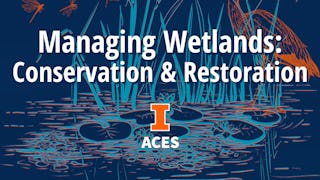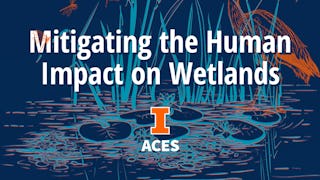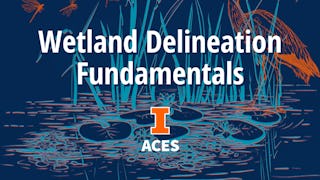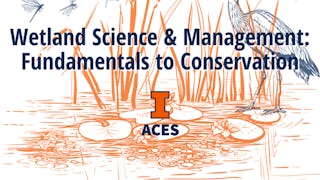In this course, learners will get familiarized with the major components of wetlands, including their formation and hydrology. They will explore the different soil types, the role of nutrient cycling, and the intrinsic connection to the resulting vegetation. The course will cover the types of plants and animals that utilize wetland habitats and their adaptations to this environment. By the end of the course, learners will have a comprehensive understanding of the structure and function of wetlands, as well as the importance of the resulting ecosystem services.

Enjoy unlimited growth with a year of Coursera Plus for $199 (regularly $399). Save now.

Discovering the Basics of Wetlands
This course is part of multiple programs.

Instructor: Jeffrey W. Matthews, Ph.D.
Included with
Recommended experience
What you'll learn
Major components of wetlands, including their formation and hydrology
Types of plants and animals that utilize wetland habitats and their adaptations to this environment
Structure and function of wetlands and the importance of their ecosystem services
Skills you'll gain
Details to know

Add to your LinkedIn profile
6 assignments
See how employees at top companies are mastering in-demand skills

Build your subject-matter expertise
- Learn new concepts from industry experts
- Gain a foundational understanding of a subject or tool
- Develop job-relevant skills with hands-on projects
- Earn a shareable career certificate

There are 4 modules in this course
In the course orientation, you will become familiar with the course, your classmates, and our learning environment. The orientation will also help you obtain the technical skills required for the course. Then dive into the second part of this module to explore the fascinating world of wetlands from wetland types to formation and hydrology. People have recognized wetlands for a long time, but it’s only more recently that we’ve started to call all these places wetlands.
What's included
10 videos8 readings2 assignments1 discussion prompt1 plugin
You will explore the foundation of wetlands and their soils in this module. The characteristics of wetlands hydric soils contribute to the unique plant and animal life found in wetland ecosystems. Explore how nutrients and energy cycling occurs in wetlands and tackle global conservation issues.
What's included
11 videos3 readings1 assignment
Wetlands are home to a unique and diverse range of organisms that have adapted to the difficulties of moisture, acidity, low oxygen, and fluctuating temperatures found in these ecosystems. You will explore the intricacies of wetland organisms and how they have adapted to thrive in a tough ecosystem.
What's included
9 videos5 readings1 assignment
Wetland structure is largely impacted by hydrology. This impacts the species present in a particular wetland and the overall structure of the wetland. You will examine the role of hydrology and it's impact on the ecosystem services and functions a wetland may provide. At the conclusion of this module, you will be ready to complete the final assessment for the course and earn your Coursera certificate!
What's included
12 videos6 readings2 assignments1 plugin
Earn a career certificate
Add this credential to your LinkedIn profile, resume, or CV. Share it on social media and in your performance review.
Instructor

Offered by
Explore more from Environmental Science and Sustainability
 Status: Free Trial
Status: Free TrialUniversity of Illinois Urbana-Champaign
 Status: Free Trial
Status: Free TrialUniversity of Illinois Urbana-Champaign
 Status: Free Trial
Status: Free TrialUniversity of Illinois Urbana-Champaign
 Status: Free Trial
Status: Free TrialUniversity of Illinois Urbana-Champaign
Why people choose Coursera for their career





Open new doors with Coursera Plus
Unlimited access to 10,000+ world-class courses, hands-on projects, and job-ready certificate programs - all included in your subscription
Advance your career with an online degree
Earn a degree from world-class universities - 100% online
Join over 3,400 global companies that choose Coursera for Business
Upskill your employees to excel in the digital economy
Frequently asked questions
Yes! Although completion of the Coursera course alone is not credit-bearing, it is a required component of a graduate-level Canvas course that can be "stacked" toward advanced credentials such as an academic (transcriptable) graduate certificate or a degree. If you decide to pursue further education, the credits you earn from this course can be applied toward a formal academic program, provided that you meet all the requirements of admission to the certificate or degree.
To access the course materials, assignments and to earn a Certificate, you will need to purchase the Certificate experience when you enroll in a course. You can try a Free Trial instead, or apply for Financial Aid. The course may offer 'Full Course, No Certificate' instead. This option lets you see all course materials, submit required assessments, and get a final grade. This also means that you will not be able to purchase a Certificate experience.
When you enroll in the course, you get access to all of the courses in the Specialization, and you earn a certificate when you complete the work. Your electronic Certificate will be added to your Accomplishments page - from there, you can print your Certificate or add it to your LinkedIn profile.
More questions
Financial aid available,

